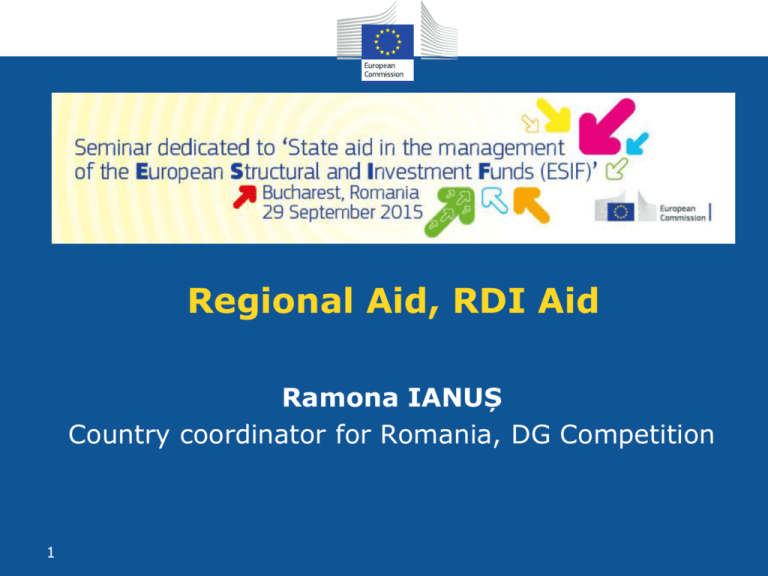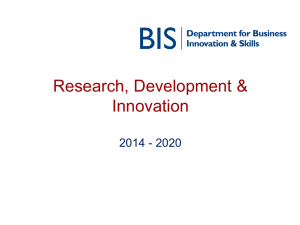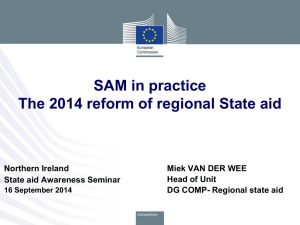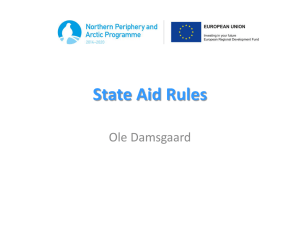Regional aid
advertisement

Regional Aid, RDI Aid
Ramona IANUȘ
Country coordinator for Romania, DG Competition
1
REGIONAL AID
2014-2020
2
Overview
1.
2.
3.
4.
5.
Regional State aid & Cohesion
Regional aid: Where?
Regional aid: What for?
Compatibility assessment of investment aid
Conclusion: Main changes RAG 2014-20
Regional aid maps
2014-2020
EU Regional State aid policy
• Exemption from the general ban on State aid for
regional aid measures:
• "Aid to promote the development of areas where the
standard of living is abnormally low or where there is
serious underemployment…" (Art. 107(3)(a) TFEU)
• "Aid to facilitate the development of … certain economic
areas…" (Art. 107(3)(c) TFEU)
• Criteria for the application of the regional aid exemptions:
• Successive Communications since early 1970’s
• Successive Regional Aid Guidelines (1998, 2006, 2013)
• Block Exemption Regulations (2006, 2008)
EU Cohesion policy – State aid
Other horizontal
aid
(training,
employment SME)
(€168 bn)*
EU cohesion policy
2007-2013
(€347 bn)
Support to
enterprise
and
innovation
(€70-80 bn)
Environment
aid
(€91 bn)*
Noncofinanced
state aid
R&D&I aid
(€74bln)*
Regional aid
(€98 bn)*
Total state aid
2007-2013
(€360 bn)*
* estimates
Regional aid reform and "SAM"
■ Communication on "State Aid Modernisation" (2012)
•
•
•
More with less: Support growth with constrained public budgets
Target enforcement on most distortive cases
More effective/efficient control: Simplify rules & streamline
procedures
■ Impact on review of regional aid rules:
•
Stricter rules for most distortive types of regional aid
•
•
•
Sectoral aid schemes, large individual aids, …
RAG 2014-2020: Adopted in 28 June 2013
Less distortive regional aid measures GBER 2014-2020
•
•
Widening of scope + lighter requirements than RAG
adopted in first half 2014
RAG 2014-2020
• Purpose of regional aid:
• To promote the development of disadvantaged areas by addressing
their economic handicaps
• To promote economic cohesion of the EU
• How?
• Support for investment and job creation by undertakings
• Support for operating expenses of undertakings (exceptionally)
• Criteria set out in RAG:
• Where can regional aid be granted?
• What can aid be granted for?
• How much aid can be granted?
1.
2.
3.
4.
5.
Regional State aid & Cohesion
Regional aid: Where?
Regional aid: What for?
Compatibility assessment of investment aid
Conclusion: Main changes RAG 2014-20
Regional aid maps
For regional aid to be effective, it needs to be focused on the
regions that suffer the most serious difficulties
• Regions with abnormally low standard of living Art. 107(3)(a)
• Reference point is EU average
• Criterion GDP/cap lower than 75% EU average
Outer Most Regions (Art. 349 TFEU)
• Other disadvantaged areas Art. 107(3)(c)
• Ex-Article 107(3)(a) regions (2011-2013)
• Sparsely populated area s
• Other problem regions with population of at least 50,000
Regional aid maps
Regional aid map also places limits on the amount of investment
aid that can be granted in each region:
Assisted area
(% EU GDP/head)
Large
firms
Mediumsized firms
Small
firms
'a' areas (<45%)
50%
60%
70%
'a' areas (45%-60%)
35%
45%
55%
'a' areas (60%-75%)
25%
35%
45%
Former 'a' areas (until end ‘17)
15%
25%
35%
Sparsely populated areas,
external border areas
15%
25%
35%
Other 'c' areas
10%
20%
30%
Regional aid maps - 3
Regional aid maps - 2014-2020
MS
Austria
Belgium
Bulgaria
Czech Republic
Cyprus
Denmark
Estonia
Finland
France
Germany
Greece
Hungary
Ireland
Italy
Latvia
Lithuania
Luxembourg
Netherlands
Malta
Poland
Portugal
Romania
Slovakia
Slovenia
Sweden
Spain
UK
EU-27
‘a’ areas
Predefined ‘c’ Non-predefined ‘c’
25.8
12.1
17.9
100
88.1
50.0
8.0
100
24.2
2.9
0
45.9
70.4
11.9
10.3
29.0
100
100
1.8
21.2
13.9
43.8
6.3
51.3
5.0
8.0
7.5
86.3
69.2
89.4
88.5
52.9
6.8
3.9
25.2
100
13.7
15.8
10.6
47.1
12.3
28.8
0.4
7.4
33.0
22.8
14.6
Total 2014-2020
25.8
29.9
100.0
88.1
50.0
8.0
100.0
26.0
24.1
25.8
100.0
76.7
51.3
34.1
100.0
100.0
8.0
7.5
100.0
100.0
85.0
100.0
88.5
100.0
12.3
68.6
27.0
47.2
Total [2013 situation]
[22.5]
[25.9]
[100.0]
[88.6]
[50.0]
[8.6]
[100.0]
[33.0]
[18.4]
[29.6]
[100.0]
[100.0]
[50.0]
[34.1]
[100.0]
[100.0]
[16.0]
[7.5]
[100.0]
[100.0]
[76.7]
[100.0]
[88.9]
[100.0]
[15.3]
[59.6]
[23.9]
1. Regional State aid & Cohesion
2. Regional aid: Where?
3. Regional aid: What for?
Initial Investment
Operating aid
4. Compatibility assessment of investment aid
5. Conclusion: Main changes RAG 2014-20
Investment aid: “Initial investment”
■ Investment in tangible and intangible assets relating to
In 'a' regions & SME in 'c' areas:
- Setting up of a new
establishment;
- Diversification of output of
establish-ment into products not
previously produced in the
establishment;
- Extension of the capacity of an
existing establishment;
- Fundamental change in the
production process.
■ Acquisition of assets linked to establishment that has closed or would have
closed
■ No replacement investment!
Investment aid: “Initial investment”
■ Investment in tangible and intangible assets relating to
In 'a' regions & SME in 'c' areas:
LEs in 'c' areas:
- Setting up of a new
- Setting up of a new establishment;
- Diversification of activity of
establishment;
- Diversification of output of
establishment, if new activity is
establish-ment into products not
not same as or similar to activity
previously produced in the
previously per-formed in the
establishment;
establishment;
- Extension of the capacity of an
- Diversification of existing
existing establishment;
establishments into new products
or new process innovations.
- Fundamental change in the
production process.
■ Acquisition of assets linked to establishment that has closed or would have
closed
■ No replacement investment!
Investment aid: “Eligible costs”
Two ways to calculate “eligible costs”:
■ Costs calculated on the basis of investment costs:
• Material assets (land, building, equipment)
• Immaterial assets:
• Transfer of technology
• Patents, operating or patented and non-patented know-how
licenses
• For large enterprises, limited to 50% of eligible costs
• Costs calculated on the basis of wage costs:
Wage costs arising from job creation as a result of the initial
investment (two-year wage cost)
Investment aid: “Conditions”
■ Conditions for regional investment aid:
• Maintenance of investment (or jobs) in the region:
•
•
5 years for large enterprises
3 years for SMEs
• 25% of investment should be from own contribution or external
finance, but totally free of public support
• Formal application for aid before works on the project started
(formal incentive effect)
Investment aid: “How much aid?”
■ Maximum allowable aid is defined as a percentage of eligible
costs of the initial investment (GGE)
■ Maximum aid intensity is set in the regional aid maps and
depends on:
• The level of development of the region
• The size of the enterprise
• The size of the investment project
•
•
Regional aid ceilings set in regional aid maps apply to investments with a total eligible cost of less
than 50 Mio €
For larger investment projects (LIPs): scaling down of maximum aid intensity ceiling
Investment aid: “LIPs”
■ LIP: Large Investment Project with eligible cost > 50 mio €:
● LIPs less affected by regional handicaps of assisted areas
● Higher risk of distortive effects (competitors, competing regions)
• Reduced aid:
• Adjusted max. aid amount = RAC x [(50 + (0.5 x B) + (0.34 x C)]
(B = Cost between 50 Mio and 100 Mio; C = Cost above 100 Mio)
• Notification threshold:
10% Region
15% Region
25% Region
35% Region
50% Region
Notification required if:
Aid > € 7.5 Mio
Aid > € 11.25 Mio
Aid > € 18.75 Mio
Aid > € 26.25 Mio
Aid > € 37.5 Mio
Operating aid
■ Operating aid:
• aimed at reducing a firm‘s current expenses
• not linked to initial investment
■ Normally prohibited
■ Permitted exceptionally in cases where investment aid alone is
not enough to trigger a process of regional development:
• The least developed ‘a’ regions (SME only)
• The sparsely populated ‘c’ regions (SME + LE)
• Outer Most Regions (SME + LE)
Operating aid: “Conditions”
■ MS has to demonstrate that the aid is :
● An appropriate instrument for addressing the specific problem
● Proportionate to the specific handicap
■ Aid should be limited in time and progressively reduced, except
in the following cases:
● Permanent handicaps of the outermost areas
● Permanent aid to offset depopulation in the least densely populated
areas
● Permanent transport aid in the outermost and low population
density areas
1.
2.
3.
4.
5.
Regional State aid & Cohesion
Regional aid: Where?
Regional aid: What for?
Compatibility assessment of investment aid
Conclusion: Main changes RAG 2014-20
Compatibility: Sectoral scope v forum shopping
Excluded from RAG but
covered by other guidelines:
■
■
■
■
Agriculture, forestry
Fisheries, aquaculture
Transport, incl. airports
Energy sector
Regional aid prohibited:
■ Steel
■ Synthetic fibres
No aid under GBER but to be
notified under RAG:
■ Shipbuilding
Covered by RAG but with
specific additional conditions
(transparency, fair access):
■ R&D infrastructure
■ Broadband networks
Compatibility Assessment
■ Common principles:
•
•
•
•
•
•
contribution to an objective of common interest
necessity of the aid
appropriateness of the aid
aid limited to the minimum necessary
avoidance of undue negative effects (black-list)
transparency of aid
■ NO aid if one principle is NOT respected
GBER v Guidelines (RAG, RDI)
COMMON
PRINCIPLE
GBER
RAG, RDI
Contribution to common
objective
Presumed
To be demonstrated
Need for state
intervention (market
failure, cohesion
objective)
Presumed for the aid categories under
GBER
RAG: Defined by Commission (regional aid maps)
RDI: to be demonstrated
Appropriateness
Presumed
To be demonstrated
Incentive effect
Application for aid before start of works
Ad hoc aid to large enterprises (stricter)
Stricter formal requirements + in depth analysis of
the counterfactual for notified individual aid
Proportionality
Maximum aid intensties
Net extra costs+max aid intensities
Negative effects
Limited by excluding more distortive aid
from GBER
Description of negative effects + BLACK list
Transparency of aid
Publication only for aid >500 000
Notification v block exemption
Exempted under new GBER:
■ Multi-sectoral schemes
■ Operating aid schemes:
• Transport aid schemes for
outermost regions + sparsely
populated areas
• Operating aid schemes for
outermost regions up to 10% of
annual sales revenues or
turnover
■ Ad hoc aid
To be notified under RAG:
■ Sectoral schemes;
■ Other operating aid schemes
■ Large schemes (annual budget >
150 million EUR)
■ Individual aid > notification
thresholds
■ Individual aid for new products
and new process innovations ('c'
regions)
■ Aid linked to relocation (closing
down similar activities in the EEA
in 2 years before or after)
Assessment of notified aid schemes
•
Objective of common interest:
• Assumed for co-financed schemes
• To be demonstrated for other schemes
•
Appropriateness: schemes are appropriate instrument
•
Incentive effect (formal requirements): start of the project after application
for aid
• For SMEs: application form
• For large enterprises: application form +documentary evidence of the
counterfactual
• Credibility check by granting authority for SMEs+LEs
•
Proportionality: net extra cost + cap (aid intensity on total costs)
• For SMEs: total costs + aid intensity
• For large enterprises: net extra cost with a cap (aid intensity on total
costs)
•
Limitation of negative effects: to ensure
that aid is not attracting an
28
investment from a poor(er) region (i.e. higher or same aid intensity as the
target region)
Notified individual awards
•
Objective of common interest: demonstration that aid contributes to regional
development strategy
•
Appropriateness: aid instrument is appropriate
•
Incentive effect: formal requirements (start of the project after submission of
application form); demonstration of the counterfactual scenario
•
Proportionality: net extra cost + cap (aid intensity on total costs)
•
Black list (negative effects outweigh any positive effects):
• NO investment aid if it attracts an investment from a poorer region
• NO investment aid if relocation of an investment due to the aid
• NO investment aid if investment takes place on a market with structural
overcapacity
29
1.
2.
3.
4.
5.
Regional State aid & Cohesion
Regional aid: Where?
Regional aid: What for?
Compatibility assessment of investment aid
Conclusion: Main changes RAG 2014-20
Main changes 2014
■ Stricter requirements under RAG 2014-20
• Compatibility assessment for notified measures outside SF
operations
• Incentive effect
• Proportionality
• Necessity of aid
• Limits on eligibility of initial investment projects by LE’s in ‘c’ areas
• No forum shopping
• Evaluation + increased transparency requirements
■ Widening of scope of GBER
• Lighter compatibility assessment requirements
AID FOR RESEARCH,
DEVELOPMENT AND
INNOVATION
2014-2020
32
Modernised R&D&I State-aid rules
Objective - Competitiveness and growth:
State aid for more and better R&D&I in the common interest.
Mobilisation of private R&D&I-investment.
Limitation of any negative effects of R&D&I State aid.
Clearer and simpler rules
Achieving the objective – modernised rules
More scope for the automatic approval of R&D&I aid – the General Block Exemption
Regulation
New aid objective ‘Research Infrastructure’; innovation aid simplified and more
generous rules - the General Block Exemption Regulation
More flexible aid ceilings for large individual aid measures – the R&D&I-Framework
Greater legal certainty for public-private R&D-collaboration and for demand-side
measures (pre-commercial public procurement) that foster innovation – the R&D&IFramework
More precise criteria for the detailed economic assessment of R&D&I-aid – faster
assessment procedure - the R&D&I-Framework
33
R&D&I State aid rules - architecture
R&D&I
-Framework 2014
presence/absence of State aid
all large individual R&D&I aid above
notification thresholds
Assessment criteria for large schemes –
focus on evaluation by MS
Innovative startupspr’s.
Process & organ’l
innovation
Innovation aid for
SMEs
innovation clusters
research
infrastructures
R&D-project aid
------------------------------------Notification threshold-------------------------------
General BlockExemption Regulation (GBER) 2014
! Notification thresholds higher than under GBER 2008 !
34
Allows ad-hoc aid for large enterprises.
Large aid schemes not eligible.
Only transparent aid instruments. All eligible R&D&I-aid objectives.
Presence of State aid in R&D&I-typical situations (Chap. 2
R&D&I-Framework)
Situation - public funding for economic activities of
research organisations and research infrastructure
Situation - R&D-services carried out by publicly financed
research organisations on behalf of industry
Situation - R&D-collaboration between publicly financed
research organisations and industry
New: Public R&D-procurement situation
The Framework’s R&D&I-specific explanations are
complementary to, and more detailed than, those given in
the forthcoming Communication on the Notion of Aid.
35
Presence of State aid in public
funding for economic activities of
research organisations and research
infrastructure
36
Public funding for research organisations/infrastructure
Non-economic activities (point 19):
Primary activities: Public education organised within the national
educational system; independent R&D; wide dissemination of research
results on a non-exclusive and non-discriminatory basis;
Knowledge transfer conducted by the research organisation/infrastructure
or jointly with/on behalf of other such entities; all profits reinvested in
primary activities.
Economic activities: e.g. renting out equipment or laboratories to
undertakings, R&D services, contract research for industry.
Cross-subsidisation of economic activities is avoided by separating the
costs, revenues and financing of economic from non-economic activities –
Lack of clear separation → Entire research organisation and its funding are
subject to State aid rules!
Separation e.g. demonstrable in annual financial statements
37
Public funding for research organisations/infrastructure
New presumption: If RO/RI is both publicly and privately
funded → State aid is present if
public funding allocated to the relevant entity for a specific
accounting period exceeds the costs of non-economic activities
incurred in that period (point 20 – footnote 22).
Example:
• Project of EUR 200 million
• Public funding = EUR 160 million (80% of the total costs) allocated to non-economic
activities → no State aid
• Remaining EUR 40 million are financed through means that do not include State
resources → no State aid
• If the public funding of the research infrastructure exceeds EUR 160 million (80% of the
total costs) – presumed State aid ('spill-over'
of public funding)
38
Public funding for research organisations/infrastructure
New concept: 'Ancillary economic activities' (point 20) not subject
to State-aid rules if
directly related to and necessary for the operation of the RO/RI
or intrinsically linked to RO/RI main non-economic use.
Must be limited in scope - consuming exactly the same inputs as non-economic
activities and allocated capacity is ≤ 20 % of relevant entity's overall annual
capacity
! Claw-back of excessive aid resulting from a higher proportion of economic activities in
comparison with ex-ante estimations!
No State aid to RO/RI as an 'intermediary':
Any advantage through public funding is quantifiable and demonstrable,
and is fully passed on to the final recipients (e.g. price-reduction)
→ State aid compatibility/de-minimis conditions at customer level,
and no further advantage for intermediary - selected with open tender
procedure, or customers are entitled to acquire services from any intermediary.
39
Example of claw-back situations
•
•
Scenario 1
•
Economic activity <20%
Cost of investment: EUR 10 million
•
•
Economic activity @30%
Excessive support: 50% * (EUR 10 million - EUR 7 million) = EUR 1.5 million
•
•
•
•
•
•
•
Scenario 2
Economic activity @ 30%
Support for business: 50% * (EUR 3 million) = EUR 1.5 million
Support for non-economic activities: EUR 7 million
Economic activity 30% -> 40%
Excessive support: 50% * (EUR 4 - 3 million) = EUR 500,000
40
41
Presence
of
indirect
State
aid
(Section 2.2) to industry through
R&D-services carried out by publicly
financed
research
organisations
(Point 2.2.1)
42
Indirect aid to industry
Contract research or research services
– How to avoid indirect State aid to undertakings?
Research service or contract research at market price, or
where there is no market price:
full costs of the service + margin commonly applied in the sector of the
service concerned, or
arm's length negotiations where research organisation/ infrastructure
negotiates to obtain maximum economic benefit at the moment when the
contract is concluded and covers at least its marginal costs.
New option: Market value of IP-ownership or IP access may be deducted from
the price if these remain with the research organisation/ infrastructure.
New presumption: Specific research service/contract research for the first time
on behalf of a given undertaking, on a trial basis and during a clearly limited period
of time → Price charged is considered as market price if service/contract research is
unique and no market for it.
43
Presence of indirect State aid (Chap.
2.2) to industry in R&D-collaboration
with
publicly
financed
research
organisations (Point 2.2.2)
44
Indirect aid to industry
R&D-collaboration with publicly financed research
organisations
– How to avoid indirect State aid to undertakings?
undertakings bear the full project costs, or
Non-IPR may be widely disseminated and any IPR generated by
research organisations/ infrastructures are fully allocated to those
entities, or
IPR/access rights allocation reflects work packages, contributions
and respective interests, or
‘compensation equivalent to market price’; undertakings' financial
and non-financial contributions to the research
organisation's/infrastructure's costs that resulted in the IPR may
be deducted.
45
Indirect aid to industry - R&D&I-Framework 2014
IPR-transfer in R&D-collaboration with publicly financed
research organisations
more elaborate explanations of ‘compensation equivalent to
the market price’
Research organisations/infrastructures enjoy the full economic benefit of IPR/access
rights, and :
open, transparent and non-discriminatory competitive sale procedure, or
independent expert valuation, or
arm's length conditions, or
where undertakings have a right of first refusal: research organisations/infrastructures
solicits offers from third parties so that the collaborating undertaking has to match its
offer accordingly.
If none of above conditions is met → full value of the contribution of the research
organisations/infrastructures is considered as an advantage for the collaborating
undertakings
→ State aid rules apply at their level.
46
New in the Framework: Presence of
State aid
in public R&D-procurement (Section
2.3) -
47
Public procurement of R&Dservices
'exclusive development'
Public-procurement Directives
apply
Open
tender/restricted
procedure pursuant
Directives
'pre-commercial' procurement
•
•
Public purchaser does not reserve all
results and benefits exclusively for
itself for conduct of its own affairs
Excludes purchase of commercial
volumes of final product/service
Public-procurement Directives do not
apply
No
aid
if
Public purchaser reserves all
results and benefits exclusively
for itself for conduct of its own
affairs
No aid if
•
open, transparent non-discriminatory procedure;
clear ex-ante arrangements; no preferential
treatment in supply of final products; wide
dissemination of non-IP; all IPR allocated to public
purchaser, or full free IP-access for public
48
purchaser and non-exclusive access for third
parties at market terms
Modernised R&D&I State-aid rules
– eligible R&D&I-aid objectives GBER Articles 24-29
49
Aid for R&D-projects
3 research categories:
fundamental research
industrial research
experimental development
New: Industrial research: now including laboratory-scale
prototypes and small scale pilot lines. Reason: High
technological risk – no commercial use – allow higher aid
intensity than for 'experimental development.
New: ex-post deduction of commercial revenues generated
by prototypes and pilots from eligible costs no longer
applicable.
Supporting the transition from development to production - fastmoving technology markets!
50
Interplay between the new GBER and the new R&D&IFramework. R&D-project aid intensities (incl. top-ups)
Large
enterprise
Mediumsized
Small
100%
100%
100%
R&D projects
-
Fundamental research
-
Industrial research -'GBER'
Industrial research – 'detailed
assessment'
50-65%
60-70%
60-75%
70-80%
70-80%
80-90%
-
Experimental development 'GBER'
Experimental development 'detailed assement
25-40%
35-50%
45-60%
60-70%
70-80%
80-90%
50%
60%
70%
-
Feasibility studies
51
Innovation aid rules – now simpler & streamlined
GBER 2008
GBER 2014
•
'Aid for young innovative
enterprises'
•
'Start-up aid' - SME access-tofinance. Various aid-instruments.
•
Various SME-innovation
objectives: IPR costs,
innovation advisory/support,
loan of highly qualified
personnel. Various levels of
aid intensities/ notification
thresholds
•
Single SME- innovation aid
category. Regular aid intensity 50% and 100% if max.
200kEUR/3 years for advisory and
support services. Single
notification threshold - 5 million
EUR/SME
•
Excluded from GBER: Aid for
process and organisational
innovation in services;
projects must be ICT-related
Excluded from GBER: Aid for
innovation clusters. Cluster
definition implies
regional/physical component.
Operating aid limited to 5
years.
•
Block-exemptible. Higher aidintensity for SMEs; no obligation
to use/exploit ICT
•
Block-exemptible. No longer
necessary to operate 'in a region'.
Higher aid intensity for investment
aid - 50%; operating aid up to 10
years degressive.
•
52
R&D Projects
1. The aided part of the project shall completely fall within the
following categories:
(a)fundamental research - experimental or theoretical work
undertaken primarily to acquire new knowledge
(b)industrial research - planned research or critical investigation
for the developing of new or the significant improvement of
current products, processes or services
(c)experimental development - acquiring, combining, shaping
and using existing knowledge and skills to develop new or
improved products, processes or services
(d)feasibility studies - evaluation and analysis of the potential of
a project
R&D Projects
Doubling the thresholds:
• Fundamental research to EUR 40 million
• Industrial research to EUR 20 million
• Experimental development to EUR 15 million
• For a EUREKA project or one implemented by a Joint
Undertakings under Article 185 TFEU double the above
thresholds
Eligible costs cover: personnel costs, costs of instruments
and equipment, costs for of buildings and land, costs of
contractual research, knowledge and patents bought or
licensed, costs of materials 54
Innovation clusters
• Innovation clusters - structures or organised groups of independent
parties designed to stimulate innovative activity
• Aid may be granted exclusively to the legal entity operating the
innovation cluster
• Notification threshold: EUR 7.5 million per cluster
• Investment and operating aid (limited to maximum 10 years)
• Aid intensities:
- Investment aid: 50% plus regional bonuses (5/15 percentage points
- Operating aid: 50%
55
Innovation aid for SMEs
• Simplified category of Innovation aid to SMEs with
streamlined conditions covering:
Aid for industrial property rights costs
Aid for the secondment of highly qualified personnel
Aid for innovation advisory and support services
• Single notification threshold – EUR 5 million per
undertaking, per project - and aid intensity – 50%
• Specific provision for aid for innovation advisory and
support services allowing to increase the aid intensity up
to100% if the aid amount remains below EUR 200 000 per
undertaking within any 3 year period
56
Process and organisational
innovation
• Aid for new or significantly improved production or
delivery method (significant changes only)
• Notification if more than EUR 7.5 million
• Aid to large undertakings only if they collaborate with
SMEs that incur at least 30 % of the total eligible costs
57
• Compatibility criteria for large
individual aid subject to the
notification obligation
• – the R&D&I-Framework
58
Assessment
principle
Assessment approach
Contribution to
increased R&D&I
and need for
State
intervention
(market failure)
Systematic identification of objective of common interest.
Appropriateness
To be demonstrated; presumed for EU-funded project
Incentive effect
Aid application before start of works
Demonstration of general/specific market failure by MS for all notified cases,
e.g. through sectoral comparison.
Presumption of absence of market failure where there are similar projects in
the market. Presumption of presence of market failure for EU funded projects.
For large individual aids, MS to support counterfactual analysis of incentive
effect with company- and industry-specific elements. Counterfactual scenario
may even consist in "the absence of an alternative project" or in "an alternative
project that is wholly or partly carried out outside the Union."
Proportionality
Where no alternative project exists: Aid must not exceed the minimum
necessary to make the project sufficiently profitable. This is the case if the
internal rate of return (IRR) is brought to a level that corresponds to sector or
firm specific hurdle rates. Where a counterfactual project exists: Aid must
not exceed the net extra costs established by comparing the expected net
present values of both alternative investments. Where a counterfactual
exists but is too remote from aided project: Hurdle-rate approach may
apply. All relevant expected costs and benefits must be considered over
the lifetime
Negative effects
Analysis of distorting dynamic incentives, creation of market power and
maintaining inefficient market structures. Analysis of choice of location.
Analysis of manifest negative59
effects, in particular if violation of EU law (such as
free movement of goods and services).
Detailed assessment of large R&D&I-aid
– incentive effect, proportionality and the
'counterfactual scenario'
• 'Counterfactual scenario' - now more elaborately described:
• "Comprehensive description of what would have happened
or could reasonably have been expected to happen without
aid".
• Alternative scenarios
clearly defined and sufficiently predictable
considered by the beneficiary undertaking in its internal
decision making
could for instance be described in internal business plans, risk
assessments, or in documents submitted to investors.
• 'Counterfactual scenario' may even consist in "the absence of an
alternative project" or in "an alternative project that is wholly or
partly carried out outside the Union."
•
60
New clarification on the cumulation of
State aid with EU-funding
total amount of State aid per activity or project
per undertaking taken into account
EU-funding not controlled by MS not taken
into account
EU-funding and State aid for same eligible costs
must not exceed most favourable funding rate
laid down in EU-law
61








